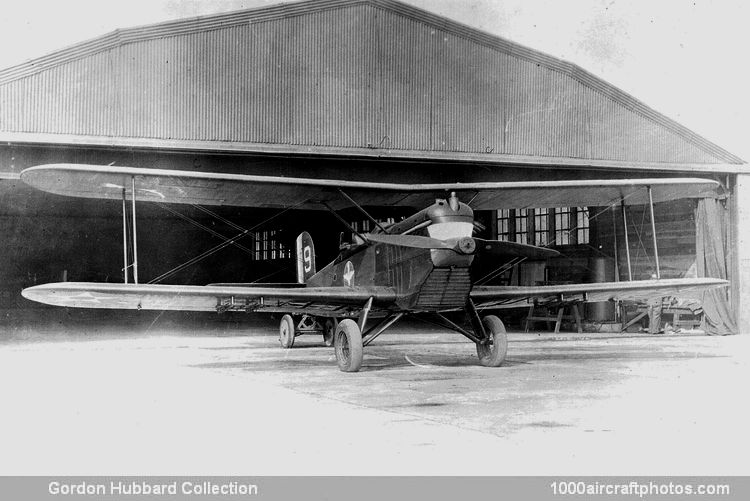06/30/2015. Remarks by Johan Visschedijk: "With a total of 879 aircraft delivered between 1924 and 1936 – comprising one civil aircraft, 108 aircraft sold to foreign air forces and 770 machines which served with all US Services (Army Air Service/Army Air Corps/Army Air Forces, National Guard, Navy, Marine Corps and Coast Guard) – the series of Douglas observation biplanes was one of the most important types of American military aeroplanes of the 1920s and early 1930s.
Amongst the last contracts drawn against Fiscal Year 1923 funds by the War Department, on behalf of the Air Service, were Contracts 728 and 821 which were awarded to The Douglas Company for the design and manufacture of two experimental observation aircraft. Both designated XO-2, these were identical with the exception of power plant, the first (s/n 157, serial 23-1251) was to be powered by a 420 hp Liberty V-1650-1 liquid-cooled engine whereas the second (s/n 167, serial 23-1254) was to be fitted with a 510 hp Packard 1A-1500 liquid-cooled engine.
Together with competitive designs ordered from American and foreign manufacturers, these two machines were intended to be entered in a series of trials at McCook Field for the purpose of selecting a Corps Observation aircraft with which to replace the aging DH-4Bs and DH-4Ms. In view of the large number of surplus Liberty engines available to the Air Service – of which an excessive number had been ordered during the war and delivered too late to be used during that conflict – the War Department further instructed the competitors to complete first the version of their aircraft powered by this type of engine, and competition trials were set for November 1924.
Completed in the Wilshire Boulevard plant during the autumn of 1924, the Liberty-powered XO-2 was tested by Eric Springer before being delivered to McCook Field. During the competitive trials, the XO-2 was evaluated with two sets of equal-span wings – a set of 36 ft 3 in (11.05 m) wings with an area of 370 sq.ft (34.373 sq.m) being substituted for the original 39 ft 8 in (12.09 m) wings with an area of 411 sq.ft (38.182 sq.m) – but the long-span wings were found to provide better handling characteristics, lower landing speed and higher ceiling and were adopted as standard.
Proving to be 22 mph (35 kmh) faster than the similarly powered DH-4B which it was to supplant and being found superior to all of its competitors, the Douglas XO-2 was recommended unanimously by the members of the Evaluation Board for Air Service adoption and was the object of the largest contract yet obtained by The Douglas Company. Awarded by the War Department on 25 February, 1925, Contract 25-421 called for the production of 75 aircraft which were delivered in 1925-26 as O-2s, O-2As, O-2Bs, O-7s, an O-8, an O-9 and an XA-2.
In the competition for Packard-powered Corps Observation aircraft held early in 1925 at McCook Field, the Douglas design was less successful and lost to the Curtiss XO-1 which had come in second in the competition for Liberty-powered aircraft. This defeat, however, proved to be a blessing in disguise as the Packard engine failed to live up to expectation and, ultimately, Douglas production of O-2s and derivatives exceeded that by Curtiss of O-1s and versions thereof. In fact, following the delivery in 1925 of the first production model in the O-2 series, the Douglas observation biplanes were built in more than fifty versions culminating in the O-2MC-10 delivered to China during 1936.
The O-2 was the first production version of which 45 (serials 25-335 to 25-379) were delivered. Generally identical to the Liberty-powered XO-2 with long span wings, production O-2s had a simplified engine installation with a large tunnel-type radiator of modified design mounted further back beneath the propeller shaft of the 435 hp Liberty V-1650-1 engine. A 30 gal (114 l) petrol tank was located in the center section of each lower wing and could be jettisoned in emergency. The landing gear consisted of two oleo legs and two Vs hinged at the center line of the underside of the fuselage. One fuselage-mounted forward-firing 0.30 in (7.62 mm) machine gun and one flexible rear-firing 0.30 in (7.62 mm) machine gun were fitted as standard armament and the aircraft carried bombs of up to 100 lb (45 kg) on four wing racks. Provision was also included for the installation of one 0.30 in (7.62 mm) machine gun over each lower wing and photographic equipment in the rear cockpit."
